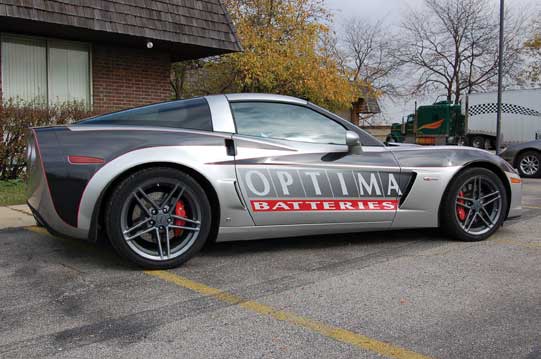Digital Printing
Published
13 years agoon

Choosing the right media is crucial to the success of your project. Have you ever been so eager to start a project that you jumped in head first without making sure you selected the right substrate for the application? Asking yourself a few basic questions will make that next job a little easier: How long will the project be displayed? Is this an indoor or outdoor project? Should I use digital or plotter film?
Choosing the right media is crucial to the success of your project. Have you ever been so eager to start a project that you jumped in head first without making sure you selected the right substrate for the application? Asking yourself a few basic questions will make that next job a little easier: How long will the project be displayed? Is this an indoor or outdoor project? Should I use digital or plotter film?
Decision matrix
After answering the questions above, use the matrix shown in Figure 1 to guide your next vinyl decision. There isn’t one magical product that will satisfy all needs for all applications, and with so many vinyl choices available, that can sometimes be a daunting task. Why these questions are important is simple. Every question eliminates a sub-section of potential vinyl choices and leads you to the final vinyl decision. Also, answers to these questions give a better understanding of job expectations and requirements.
Obviously, there are exceptions to every rule. Just as there isn’t one vinyl film that fits all applications, this matrix will not fit every potential application need. If you are trying to learn more about making decisions in the vinyl world, this matrix is a good way to begin.
Short vs. long term
Want to save money? If so, then you have to determine how long the project will be displayed. This one question can potentially save you and your customer a lot of dough. Here’s how.
Let’s assume you asked your customer about the longevity expected for the project and you got this reply: “I want a wall mural on my restaurant wall but want to be able to remove it in a year or two because we hope to remodel the place.” Looking at the decision matrix , you see this is considered a short-term project because they expect to have the graphic in place less than five years.
Looking at the decision matrix for short-term projects, you now learn that a calendered film is the best choice. Great! You have just potentially saved yourself a lot of money because there isn’t a need for a more expensive cast film. In this example, the next two questions were also answered, further defining that a calendered digital film with water-based adhesive is recommended. In addition to saving money by choosing a calendered film, you have saved even more by choosing a film with water-based adhesive instead of a typically more expensive film with solvent-based adhesive. We’re on a roll!
Indoor or outdoor?
The question of indoor vs. outdoor helps you to better understand the limitations and expectations for the project and determine the proper vinyl for the application.
As you might expect, outdoor applications require greater capabilities from a film. Films used outdoors have a much greater chance of shrinkage, UV damage, color fading, and aging as a result of weathering. A generally accepted rule of thumb for outdoor use for greater than five years is to use a cast or high-performance, calendered film for the best, long-term results and greatest return on investment.
Cast films have inherent properties that make them more weather resistant, durable, conformable, resistant to shrinkage, and maintain color better. Because of the raw materials used during the manufacturing process of cast films, durability and weather resistance are generally higher and shrinkage is less than most calendered films. Another advantage of the cast-film-manufacturing process is they are typically made very thin, which allows for much greater conformability over substrates with rivets, corrugations, and complex curves.
Using a thicker, more rigid, calendered film is ideal when the project calls for one or more of the following: less than five years of durability, indoor application, and no requirement for stretch or conformability. Typical calendered film uses are floor graphics, wall murals, and P-O-P displays.
Unlike outdoor applications, indoor applications generally require less rigorous demands. A large number of indoor applications are flat substrates for temporary or short-term use, where more expensive, durable, flexible cast films are not needed.
Granted, there are exceptions to everything. For example, what if a customer were to come to you with the idea of a window graphic in the food court of a mall? Technically, the graphic could be installed indoors, and it’s a flat substrate, which may lead you to believe you could use a calendered film. However, because of exposure to direct sunlight and the likelihood that the graphics would need to stay in place for several years, using a calendered film would not
be the best solution.
Digital vs. plotter film
We are nearly done. The last question, whether to use a digital or plotter film, is relatively easy to answer. By the time you reach this question, you already have a good sense of the pro-ject and have narrowed the vinyl choices considerably.
Here’s an example of how easy this question is to answer. A customer wants a vehicle wrap of their favorite superhero on their Volkswagen Beetle that will last more than five years. Because the customer wants the wrap to last longer than five years, this is considered a long-term project. This narrows your choices to a high-performance calendered or cast film. Obviously, this is an outdoor application; therefore, a solvent-based adhesive is recommended. This eliminates most plotter and calendered films.
For this project, the next decision is whether to choose a digital or plotter film. The underlying question is whether you want a solid color or a digitally printed wrap. The preferred wrap of choice for this application is a digitally printed wrap, thus eliminating all plotter films.
Another consideration for this job is the compound curves of the car, which require an extremely conformable product. This automatically narrows your choice to a cast film. Cast films provide the best solution for outdoor projects requiring conformability and long-term durability.
Vinyl choices for vehicle wraps
One of the most popular uses of vinyl films these days is vehicle wrapping (Figure 2). You see wraps more frequently than you might think. People are using them in a variety of ways, from promoting their business to changing the color of their vehicle—red today, green tomorrow. While we have touched a little on wraps, let’s take a closer look.
Using the matrix, a vehicle wrap is considered a long-term, outdoor project requiring a high-performance calendered or cast film with a solvent-based adhesive. Choosing a solvent-based vinyl film for vehicle wraps is critical if you want to avoid potential vinyl failures.
The decision to use a high-performance calendered or cast film is based on the need for conformability. As in the example of the Volkswagen Beetle, a cast film is required to handle the extreme conformability needed for the contours of the fenders. However, if the vehicle is relatively flat, like a box truck, then a high-performance calendered film would work well.
Whether to use a digital or plotter vinyl film for the project depends on whether there is a need for digital images within the wrap or whether a solid-colored wrap is required. After you have chosen, don’t forget to select a laminate. This will add longevity to your vehicle wrap. When choosing a laminate, remember to match the grade of the film with the grade of the laminate. For example, if you are using a cast vinyl film use a cast laminate. Cast and calendered films expand and contract differently. Choosing the same grade
of film and laminate will keep graphics from buckling.
Prior to installation
It is highly recommended that you determine whether the vehicle has an OEM factory paint job before installing any graphics. If the car has ever been repainted, there is a possibility that when the film is removed the paint may be removed as well. Just as a doctor informs his patients of potential risks of a procedure, it’s a good idea to prepare your customer in advance that this could occur with a non-OEM factory installed paint job.
A little prep work is needed before any graphic installation. For vehicle wraps, it is highly recommended that the car be thoroughly cleaned with an industrial degreaser, followed by soap and water, to remove any degreaser residue. Once the car has been washed, follow by wiping the car down with isopropyl alcohol to remove any soap and water residue. Now let’s talk about preventing vinyl failure. Before printing Use vinyl manufacturer color profiles for specific films when printing to avoid edge curling and adhesive failure.
After printing Allow graphics to properly outgas prior to laminating, cutting, or installing; install graphics when the surface of the car is approximately 70°F; and create a mental game plan for the installation to think through potential challenges and pitfalls.
After installation Go over all contours, seams, and rivets with heat and pressure to ensure adhesion and bonding. Allow sufficient time for the vinyl’s adhesive to bond to the car before moving the vehicle to an extreme difference in temperature. For example, if installation environment is approximately 72°F and the outside temperature is 30°F, then do not place the car outside until the adhesive has a chance to adhere sufficiently to the car.
Making your vinyl decision final
Now that you have figured out how to make vinyl decisions for future projects, take some time to learn more about the wide variety of manufacturers and the products that are available. The good news for you is that most vinyl manufacturers have a wealth of product information in the way of Websites and collateral materials to further educate you.
Technical data sheets, features and benefits, product bulletins, color charts, digital guides, and a variety of other marketing pieces typically are available. All of these informational materials provide additional data concerning product thickness, shrinkage, typical applications/uses, and durability. Samples may even be available.
If you have chosen a digital film, check out the latest color profile recommended by the manufacturer. Each product has its own unique color profile that will provide the best settings for your printer, RIP software, and ink combination.
Last, but certainly not least, if you ever have questions about a product or what to use for a particular application, we highly recommend that you contact the vinyl manufacturer’s technical-support team. They are usually the best people to call when you ever have a concern. In a lot of cases, they’ve worked in sign shops and have a wealth of product and application knowledge.
Lisa Humrich is marketing manager for Black Creek, GA-based Oracal USA, Inc. Dean Strohmenger is a product-support specialist at Oracal USA, Inc.

Subscribe

Magazine
Get the most important news
and business ideas from Screenprinting Magazine.
Most Popular
-

 Art, Ad, or Alchemy1 month ago
Art, Ad, or Alchemy1 month agoF&I Printing Is Everywhere!
-

 Case Studies1 month ago
Case Studies1 month agoHigh-Density Inks Help Specialty Printing Take Center Stage
-

 Andy MacDougall1 month ago
Andy MacDougall1 month agoFunctional and Industrial Printing is EVERYWHERE!
-

 Columns2 weeks ago
Columns2 weeks ago8 Marketing Mistakes Not to Make When Promoting Your Screen Printing Services Online
-

 Editor's Note2 weeks ago
Editor's Note2 weeks agoLivin’ the High Life
-

 Thomas Trimingham2 months ago
Thomas Trimingham2 months ago“Magic” Marketing for Screen Printing Shops
-

 Marshall Atkinson2 weeks ago
Marshall Atkinson2 weeks agoHow to Create a Winning Culture in Your Screen-Printing Business
-

 News & Trends1 month ago
News & Trends1 month agoWhat Are ZALPHAS and How Can You Serve Them in Your Print Business?






